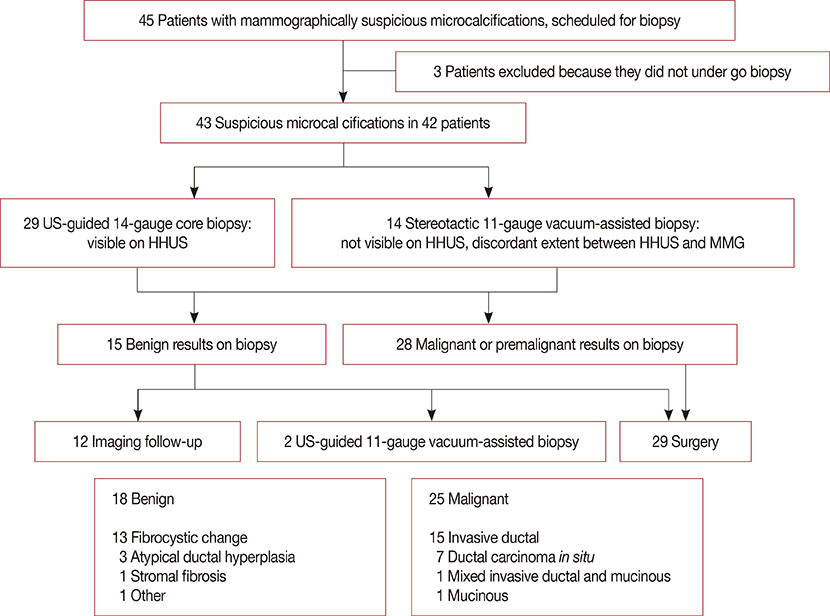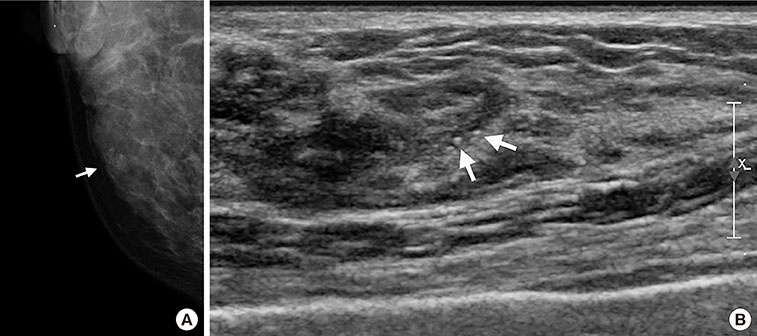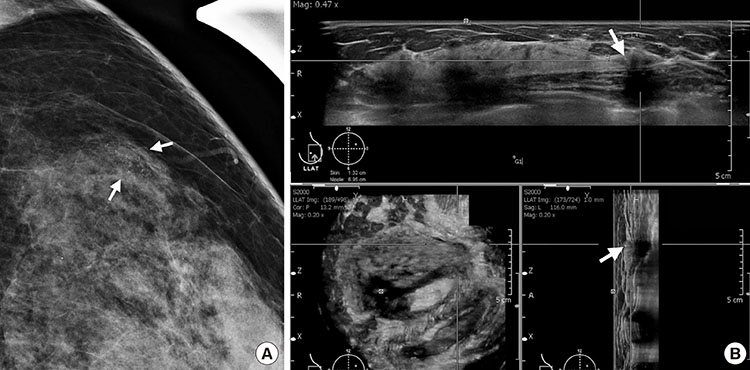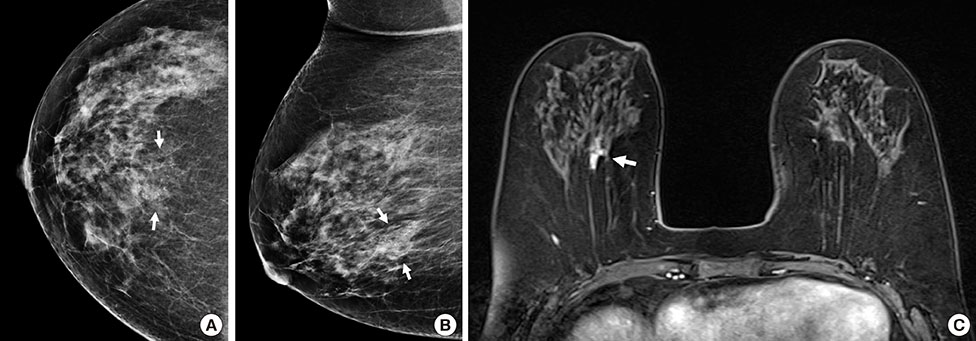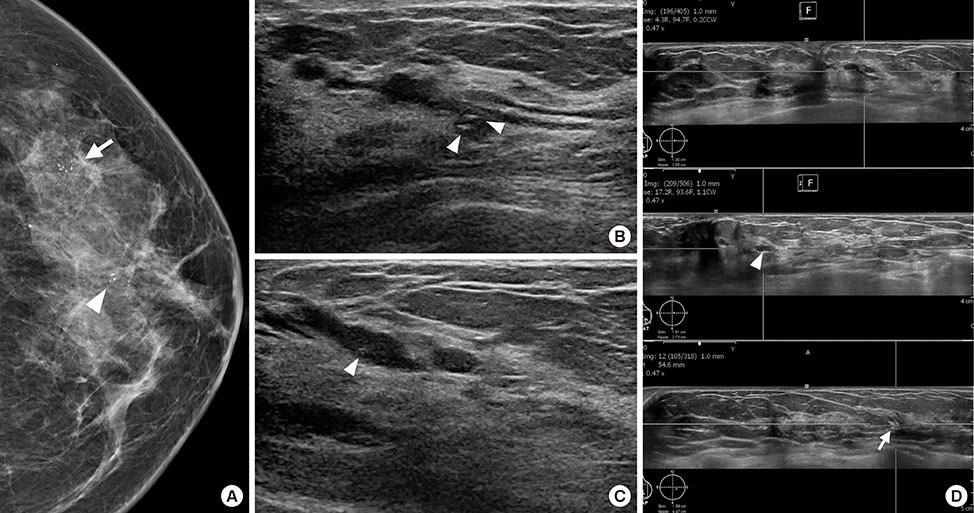J Breast Cancer.
2016 Dec;19(4):429-437. 10.4048/jbc.2016.19.4.429.
Detectability and Usefulness of Automated Whole Breast Ultrasound in Patients with Suspicious Microcalcifications on Mammography: Comparison with Handheld Breast Ultrasound
- Affiliations
-
- 1Department of Radiology, Dongtan Sacred Heart Hospital, Hallym University Medical Center, Hwaseong, Korea.
- 2Department of Radiology, Seoul St. Mary's Hospital, The Catholic University of Korea College of Medicine, Seoul, Korea. rad-ksh@catholic.ac.kr
- 3Department of General Surgery, Seoul St. Mary's Hospital, The Catholic University of Korea College of Medicine, Seoul, Korea.
- KMID: 2362930
- DOI: http://doi.org/10.4048/jbc.2016.19.4.429
Abstract
- PURPOSE
The purpose of this study was to prospectively evaluate the detectability and usefulness of automated whole breast ultrasound (AWUS) and to compare it with handheld breast ultrasound (HHUS) in cases with suspicious microcalcifications identified by mammography.
METHODS
Forty-two patients with 43 suspicious microcalcifications (25 malignant and 18 benign) detected by mammography underwent AWUS, HHUS, and histol-ogic examination. With knowledge of the mammographic findings, HHUS was performed to assess the visibility of the microcalcifications and the presence of associated masses or ductal changes. Two radiologists reviewed the AWUS images in consensus using the same methods employed for HHUS. Detectability of AWUS was compared with that of HHUS and was correlated with histologic and mammographic findings.
RESULTS
Of the 43 lesions, 32 (74.4%) were detectable by AWUS and 31 (72.1%) by HHUS. No significant differences in sensitivity were found between the two methods (p=0.998). AWUS detected 96% (24/25) of malignant microcalcifications and 44.4% (8/18) of benign microcalcifications. AWUS was more successful in the detection of malignant vs. benign lesions (96.0% vs. 44.4%, p=0.002), lesions >10 mm vs. ≤10 mm in size (86.7% [26/30] vs. 46.2% [6/13], p=0.009), lesions with a fine pleomorphic or linear shape vs. a round or amorphous or coarse heterogeneous shape (94.7% [18/19] vs. 58.3% [14/24], p=0.021), and lesions associated with a mass or architectural distortion vs. without obvious changes on mammography (100% [19/19] vs. 54.2% [13/24], p=0.022).
CONCLUSION
Detectability of AWUS was comparable to that of HHUS in cases where suspicious microcalcifications were identified on mammography. Therefore, AWUS might be helpful in the performance of ultrasound-guided percutaneous procedures for highly suspicious microcalcifications.
MeSH Terms
Figure
Reference
-
1. Sickles EA. Breast calcifications: mammographic evaluation. Radiology. 1986; 160:289–293.
Article2. Sickles EA. Mammographic features of 300 consecutive nonpalpable breast cancers. AJR Am J Roentgenol. 1986; 146:661–663.
Article3. Ciatto S, Cataliotti L, Distante V. Nonpalpable lesions detected with mammography: review of 512 consecutive cases. Radiology. 1987; 165:99–102.
Article4. Meyer JE, Kopans DB, Stomper PC, Lindfors KK. Occult breast abnormalities: percutaneous preoperative needle localization. Radiology. 1984; 150:335–337.
Article5. Meyer JE, Eberlein TJ, Stomper PC, Sonnenfeld MR. Biopsy of occult breast lesions: analysis of 1261 abnormalities. JAMA. 1990; 263:2341–2343.
Article6. Orel SG, Kay N, Reynolds C, Sullivan DC. BI-RADS categorization as a predictor of malignancy. Radiology. 1999; 211:845–850.
Article7. Moon WK, Im JG, Koh YH, Noh DY, Park IA. US of mammographically detected clustered microcalcifications. Radiology. 2000; 217:849–854.
Article8. Gufler H, Buitrago-Téllez CH, Madjar H, Allmann KH, Uhl M, Rohr-Reyes A. Ultrasound demonstration of mammographically detected microcalcifications. Acta Radiol. 2000; 41:217–221.
Article9. Hashimoto BE, Kramer DJ, Picozzi VJ. High detection rate of breast ductal carcinoma in situ calcifications on mammographically directed high-resolution sonography. J Ultrasound Med. 2001; 20:501–508.
Article10. Cheung YC, Wan YL, Chen SC, Lui KW, Ng SH, Yeow KM, et al. Sonographic evaluation of mammographically detected microcalcifications without a mass prior to stereotactic core needle biopsy. J Clin Ultrasound. 2002; 30:323–331.
Article11. Soo MS, Baker JA, Rosen EL, Vo TT. Sonographically guided biopsy of suspicious microcalcifications of the breast: a pilot study. AJR Am J Roentgenol. 2002; 178:1007–1015.
Article12. Soo MS, Baker JA, Rosen EL. Sonographic detection and sonographically guided biopsy of breast microcalcifications. AJR Am J Roentgenol. 2003; 180:941–948.
Article13. Shipley JA, Duck FA, Goddard DA, Hillman MR, Halliwell M, Jones MG, et al. Automated quantitative volumetric breast ultrasound data-acquisition system. Ultrasound Med Biol. 2005; 31:905–917.
Article14. Tozaki M, Fukuma E. Accuracy of determining preoperative cancer extent measured by automated breast ultrasonography. Jpn J Radiol. 2010; 28:771–773.
Article15. Kim SH, Kang BJ, Choi BG, Choi JJ, Lee JH, Song BJ, et al. Radiologists' performance for detecting lesions and the interobserver variability of automated whole breast ultrasound. Korean J Radiol. 2013; 14:154–163.
Article16. Shin HJ, Kim HH, Cha JH, Park JH, Lee KE, Kim JH. Automated ultrasound of the breast for diagnosis: interobserver agreement on lesion detection and characterization. AJR Am J Roentgenol. 2011; 197:747–754.
Article17. Lin X, Wang J, Han F, Fu J, Li A. Analysis of eighty-one cases with breast lesions using automated breast volume scanner and comparison with handheld ultrasound. Eur J Radiol. 2012; 81:873–878.
Article18. Wang HY, Jiang YX, Zhu QL, Zhang J, Dai Q, Liu H, et al. Differentiation of benign and malignant breast lesions: a comparison between automatically generated breast volume scans and handheld ultrasound examinations. Eur J Radiol. 2012; 81:3190–3200.
Article19. Kotsianos-Hermle D, Hiltawsky KM, Wirth S, Fischer T, Friese K, Reiser M. Analysis of 107 breast lesions with automated 3D ultrasound and comparison with mammography and manual ultrasound. Eur J Radiol. 2009; 71:109–115.
Article20. Kotsianos-Hermle D, Wirth S, Fischer T, Hiltawsky KM, Reiser M. First clinical use of a standardized three-dimensional ultrasound for breast imaging. Eur J Radiol. 2009; 71:102–108.
Article21. An YY, Kim SH, Kang BJ. The image quality and lesion characterization of breast using automated whole-breast ultrasound: a comparison with handheld ultrasound. Eur J Radiol. 2015; 84:1232–1235.
Article
- Full Text Links
- Actions
-
Cited
- CITED
-
- Close
- Share
- Similar articles
-
- Reliability of automated versus handheld breast ultrasound examinations of suspicious breast masses
- Clinical Applications of Automated Breast Ultrasound: Screening for Breast Cancer
- Automated Breast Ultrasound
- Calcifications on Breast Ultrasonography
- Usefulness of Ultrasound-Guided Automated Core Biopsy of Nonpalpable Breast Lesions

